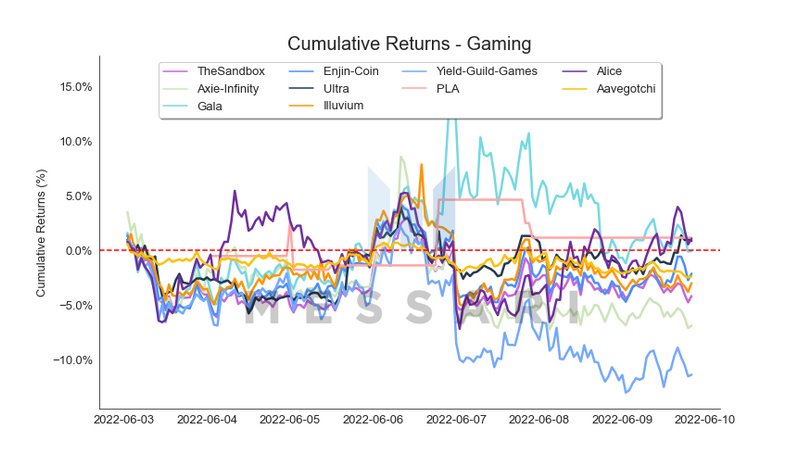Notable Messari Intel Updates
- The Osmosis blockchain was halted by validators for emergency maintenance to address an exploit that led to a loss of funds in some Osmosis liquidity pools. The Osmosis team has indicated that they have identified the critical bug and are testing a fix before relaunching the blockchain.
- The Moonbeam Foundation has announced that it has partnered with Arrington Capital to launch a $100 million ecosystem fund dedicated to supporting projects built on the Moonbeam network.
- According to reporting from Bloomberg, US regulators are investigating whether Binance Holdings Ltd. broke securities rules by selling digital tokens during the BNB ICO in 2017. According to the report, “Investigators are examining if the 2017 initial coin offering amounted to the sale of a security that should have been registered with the agency.”
- HIP-406, a proposal to implement staking on Hedera mainnet, has been accepted. Currently, the governing council controls all nodes deployed on the Hedera network, and each node has an equal stake. To further decentralize the Hedera protocol, the core team advocates enabling uneven staking rewards and allowing users to delegate HBAR to different validators on the network.
- Following the initial launch of Bancor 3, more than 100 pools are now live on Bancor 3 including AAVE, AXS, BAT, ENJ, MATIC, SNX, USDC, USDT, wNXM, WOO, and YFI. This is in addition to the four tokens initially launched, ETH, DAI, LINK, and BNT.
Notable Messari Governor Updates
- The Goldfinch DAO submitted a proposal that aims to approve the member rewards as phase 1 of Goldfinch’s updated tokenomics. The Goldfinch Membership system will allow members to receive a share of the protocol fees and greater governance voting power, similar to Curve governance. Preliminary discussions are ongoing.
- The Merit Circle DAO succeeded in passing a proposal that aims to counter MIP 13, which called for the removal of Yield Guild Games and Nifty as stakeholders by reverting their stream and refunding their initial contribution. This proposal instead suggests the terms of the financial agreement between Merit Circle DAO, Yield Guild Games, and Nifty Fund be renegotiated in a way that is agreeable to all parties.
- The Developer DAO succeeded in passing a proposal that aims to amend P 9, which allocated 1,000 GTC per full-time contributor, monthly. Due to the GTC price action, it is proposed that this amount be adjusted. To cover the expense of these adjustments, this proposal suggests using ETH in the DAO’s treasury to purchase an additional 5,000 GTC. This will serve as a way to increase short-term allocations for retaining core staff.
- The Optimism Collective has submitted a proposal that aims to distribute 34.4 million OP tokens to projects requesting funding during Phase 0 of the Optimism Foundation’s Governance Fund. The 21 projects that applied before May 27, 2022, have been bundled into a batch vote and will be voted on as a whole. Voting is currently active.
- The Sushi DAO has submitted a proposal that aims to form a partnership with KlimaDAO and implement automated carbon offsetting into DEX transactions on Polygon. Preliminary discussions are ongoing.
Sector Returns
The crypto markets have predominantly seen more sideways action during this week. However, the question has to be asked whether the markets will continue to see further downside following the expected elevated inflation numbers to be released. Three of the sectors covered with the highest market capitalization — DeFi, Smart Contract Platforms, and Currencies — saw muted returns while the lower market cap sectors went in opposite directions. Web3 has secured two winning weeks in a row and ended this week with a return of 6.02%.
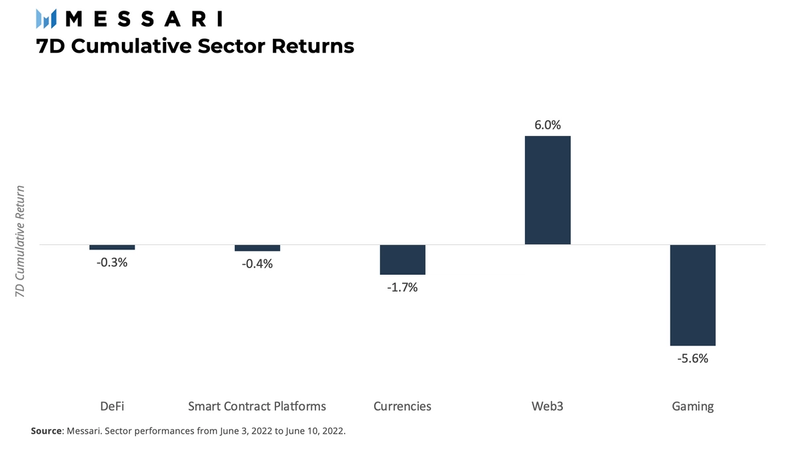
DeFi Assets
Only two top DeFi assets ended above water as the DeFi sector gave a lackluster performance this week. The sector had a midweek spike that momentarily sent all top assets to positive territory; however, the short-lived rally changed direction and left most in the red. PancakeSwap (CAKE) and THORChain (RUNE) were the only two survivors, posting 1.1% and 0.5% returns, respectively. Aave (AAVE) was the worst performer of the group, declining 13.0% this week.
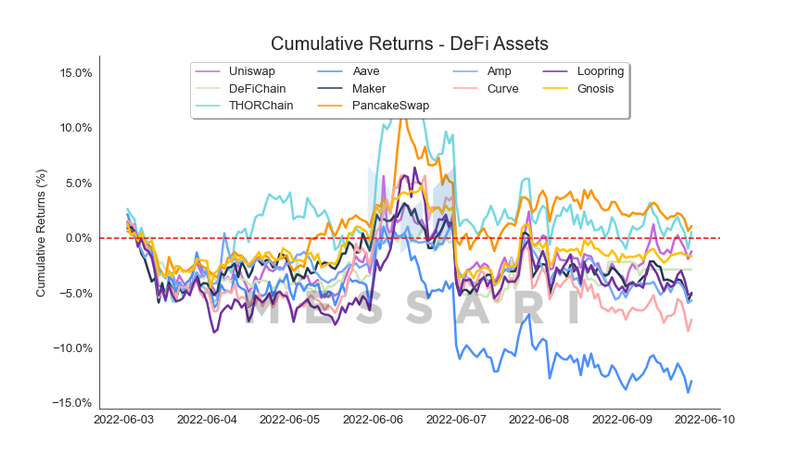
Messari has recently adopted the use of a metric called Global TVL/Market Cap as a way to better understand DeFi activity. This metric adjusts for prices in assets and provides a better view into how much value lies within DeFi. It will be featured in the Weekly Recap moving forward.
The graph on the left shows the historic Global TVL/Market Cap, and the right one shows a zoomed in version of the metric from mid April to early June. The decline from 10% to 8% on the charts is marked by the implosion of Luna and its rippling effect on the DeFi landscape, where 20% of DeFi evaporated. However, what is more interesting is that even though the market has been on a bearish trend, Global TVL/Market Cap was on the rise pre-Luna crash and has remained on a relatively stable trend since.
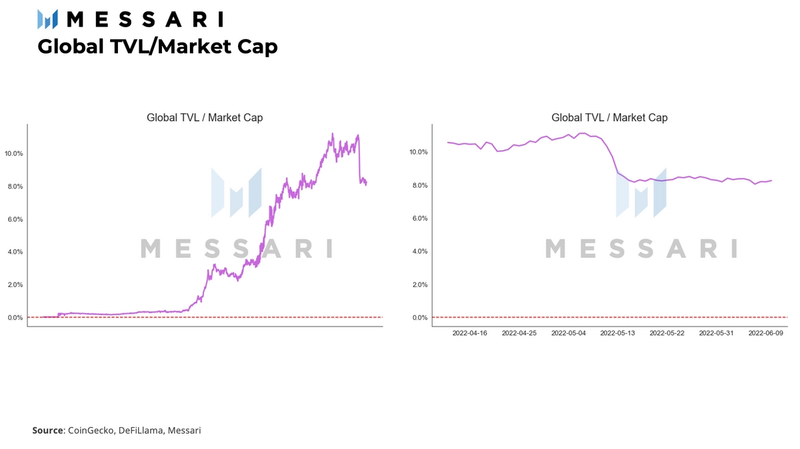
Smart Contract Platforms
Smart Contract Platform assets went through a similar midweek spike as with DeFi assets. The main difference here is that following the immediate selloff, several tokens saw a secondary and prolonged rally that left them far above the rest. Among those were Cardano (ADA) and Algorand (ALGO) and, to a lesser extent, Avalanche (AVAX). These three assets ended the week with returns of 7.9%, 3.4%, and 0.4%, respectively. NEAR Protocol (NEAR) was the biggest loser of the group, with a return of -7.5%.
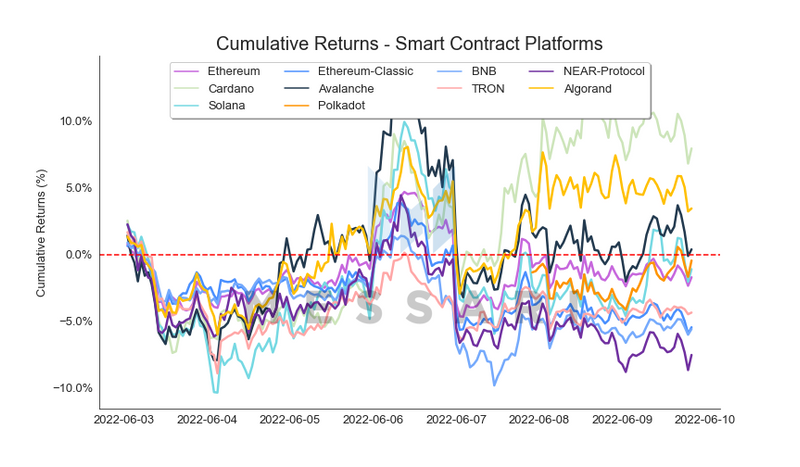
Currencies
Similar to DeFi, currencies only had two assets that ended the week in green territory. The assets were Bitcoin SV with a return of 2.4% and Zcash with a return of 1.0% on the week. The top currencies traded within a tight channel this week and had the smallest range of returns within the sectors covered (11.2%). Monero secured the endmost position this week with an 8.8% decline.
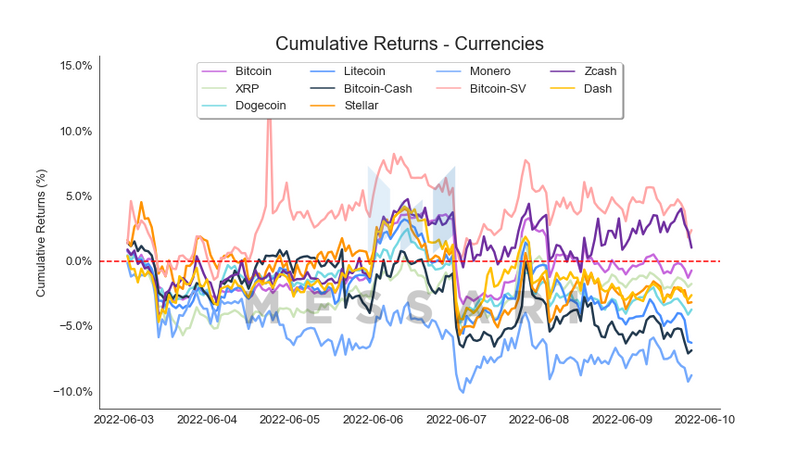
Web3
Contrary to currencies, Web3 had the widest range of returns among the sectors covered this week (49.9%). Leading the pack and contributing to the wide spread between returns were Helium (HNT) and Chainlink (LINK). The two tokens’ prices benefitted from noteworthy news of upgrades that are scheduled to come. Chainlink recently announced its new roadmap which included the implementation of staking for the LINK token and Helium recently approved a proposal aimed at scaling the network to support new users, devices and networks. HNT posted a weekly return of 37.1% while LINK returned 30.0%.
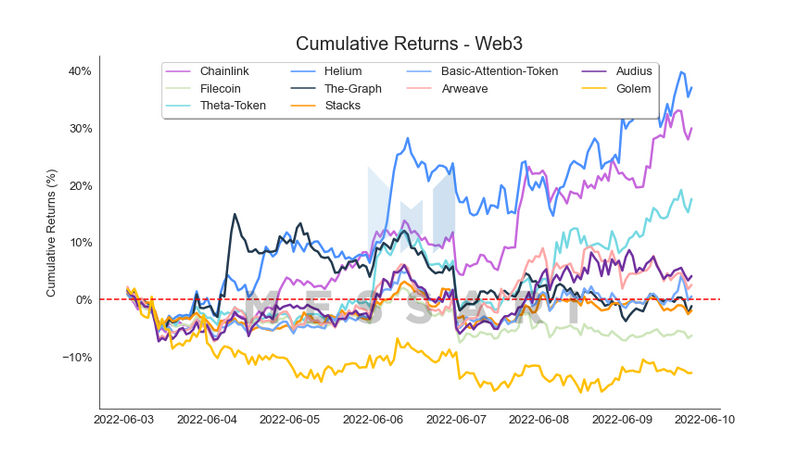
Gaming
Gaming took the opposite direction compared to Web3 and secured its spot as the worst performer of the week. The main driver behind the lagging performance for the sector can be attributed to the double-digit loss of 11.4% by Yield Guild Games (YGG) which dragged the rest of the sector down. Two of the highest market cap tokens among the sector were also among the biggest losers — The Sandbox (SAND) and Axie Infinity (AXS). SAND posted a 4.2% loss while AXS declined 6.9% on the week.
